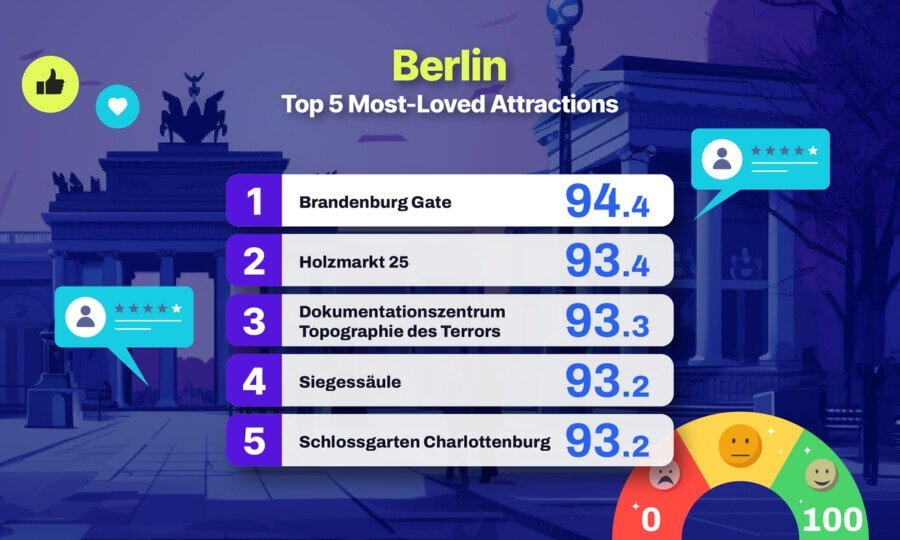Tower Bridge holds the top spot as London’s most reviewed tourist attraction, while Primrose Hill Park is the one boasting the highest sentiment.
Similarly, in Berlin, Alexanderplatz receives the most reviews, however the Brandenburg Gate stands out for having the highest sentiment.
Why is it important for a tourist destination to have a full understanding of how attractions are perceived?
- To comprehend visitor preferences
- To intercept behaviours
- To create more impactful territorial marketing strategies
- To pinpoint high-traffic areas and prevent overtourism situations
To demonstrate this, we conducted an analysis of the most-reviewed and highly-rated attractions in London and Berlin using our destination management platform, D / AI Destinations.
What were the key findings?
TABLE OF CONTENTS
Tower Bridge is the most-reviewed attraction in London
Tower Bridge secures the leading position among attractions, boasting the highest volume of reviews (nearly 20,000) in the past year, coupled with an equally impressive Sentiment Score (approaching 96/100).
- Tower Bridge: 19686 reviews (Sentiment 95.75/100)
- London Eye: 19394 reviews (Sentient 90.98/100)
- The British Museum: 18718 reviews (Sentiment 91.77/100)
- Tower of London: 15390 reviews (Sentiment 93.17/100)
- Hyde Park: 12273 reviews (Sentiment 94.82/100)
In short, the review analysis illustrates a rich and varied London tourism scene, featuring renowned attractions scattered throughout various zones of the city.
Visitors are captivated by parks and gardens
Hyde Park is the only attraction that approaches the Tower of London’s performance, with over 12,000 reviews and an impressive sentiment rating of 95/100. This pattern isn’t unique, as the most highly valued attractions overall consist entirely of parks and gardens.

The ratings for these places are notably lower in contrast to the highly reviewed attractions, which somewhat contributes to the inherently higher Sentiment Score.
However, it’s evident how both tourists and travellers deeply appreciate London’s numerous green spaces, which are scattered throughout every part of the city.
It’s worth noting that London is positioned as one of Europe’s most eco-friendly cities, with 8 Royal Parks that collectively extend over 20 square kilometres.
What are the reasons behind this pattern?
- Safety: Following the Covid crisis, people are reconsidering open spaces, preferring less crowded areas suitable for various activities like sports, picnics, and leisure.
- Cleanliness: The English are renowned for their appreciation of green spaces. Parks, universally accessible, free of charge, clean, and impeccably maintained, have become a cornerstone for holidaymakers.
- Relaxation: In bustling urban areas, there is a tendency to seek out serene locations to unwind and enjoy leisure time with family away from traffic.
- Accessibility: Parks, being both accessible and free, draw in a diverse range of visitors.
- Diverse activities: These venues frequently host cultural events such as exhibitions, performances, children’s play areas, lakes, etc.
- Seasonal appeal: These locations remain attractive year-round, adapting to varying interests and preferences throughout different seasons.
Alexanderplatz is the most-reviewed attraction in Berlin, while the Brandenburg Gate holds the highest sentiment
In Berlin, the tourist attractions with the greatest number of reviews are among the most renowned overall. While Alexanderplatz stands out for its content volume, the Brandenburg Gate, securing the second position, also boasts the highest Sentiment Score.
- Alexanderplatz: 21129 reviews (Sentiment 85.22/100)
- Brandenburger Gate: 10606 reviews (Sentiment 94.4/100)
- Checkpoint Charlie: 9892 reviews (Sentiment 85.44/100)
- East Side Gallery: 6464 reviews (Sentiment 92.67/100)
- Potsdamer Platz: 6334 reviews (Sentiment 86.73/100)
Parks and open spaces are highly sought-after in Berlin as well. Among the top favourites are Holzmarkt 25, a cultural and innovative venue situated along the banks of the Spree River, and the stunning park surrounding Charlottenburg Palace.

Territorial marketing and the pivotal role of attractions
For destination marketers crafting an integrated territorial marketing strategy, undertaking an analysis such as this can be extremely valuable in strategic decision-making. It aids in setting objectives, gaining a clearer understanding of the target audience, and assessing key strengths to leverage.
Specifically, leveraging sentiment and popularity data of attractions can help in:
- Understanding visitor preferences and behaviours: Where do tourists typically go? Which attractions garner the most attention? Do tourists generally have preferred paths or travel routes? How have rankings evolved over time? These factors are crucial in shaping a more accurate profile of the traveller you need to target.
- Crafting more engaging territorial marketing content: London and Berlin offer a multitude of attractions, posing a challenge for destination marketers.
What should be displayed in a promotional video from numerous options?
Are there recurring themes to emphasise for creating compelling messages?
How should a website be structured and what content to show to immediately resonate with travellers?
What should be featured in upcoming newsletters or on social media to attract attention?
Understanding reviews offers valuable insights for crafting compelling and engaging content that aligns with audience expectations.
Overtourism: Using reviews as a warning sign
The assessment of reviews for tourist attractions can aid in identifying the most frequented areas and neighbourhoods by tourists.
This allows local authorities to more effectively handle visitor arrivals by implementing strategies to evenly distribute tourist traffic and prevent instances of overtourism.
New attractions could be introduced or less familiar ones promoted to encourage visitors to explore various parts of the area, thereby reducing congestion in the city’s central zones.
- For instance, Kyoto has implemented a real-time virtual map highlighting congested zones.
- Meanwhile, Amsterdam has redirected attention to neighbourhoods beyond the historic centre, encouraging tourists to explore areas like Noord and Oost or lesser-known museums.
Interested in discovering more about using big data to address overtourism?
> Download the free eBook
It’s interesting to observe that the attractions receiving the most reviews don’t consistently align with those having the highest sentiment, and vice versa.
These diverse metrics offer a more holistic perspective on the popularity and appreciation of individual tourist attractions and ongoing tourism trends, providing invaluable data for a DMO or DMC.





